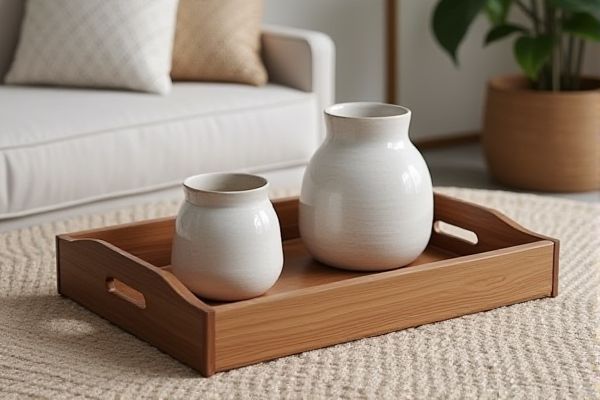
Decorative trays enhance your living space with stylish designs and accent pieces, while storage trays focus on organizing and safely containing items to reduce clutter. Discover how choosing the right tray type can transform Your space by reading the rest of the article.
Table of Comparison
| Feature | Decorative Tray | Storage Tray |
|---|---|---|
| Primary Purpose | Enhances room aesthetic and displays items | Organizes and stores items efficiently |
| Design | Stylish, ornamental, often elaborate | Functional, simple, durable materials |
| Material | Wood, metal, glass, ceramic | Plastic, fabric, metal, wood |
| Size | Varies, often medium to large for display | Varies, optimized for storage space |
| Usage | Showcasing decor, serving drinks | Storing accessories, tools, or household items |
| Accessibility | Items visible and easy to access | Items often stacked or compartmentalized |
| Versatility | Primarily decorative with some utility | Primarily utilitarian with some decorative options |
Introduction to Decorative Trays and Storage Trays
Decorative trays enhance your living space by combining style and functionality, often featuring intricate designs or luxurious materials to complement your home decor. Storage trays prioritize organization and practicality, offering compartments or stackable designs to efficiently manage clutter in various rooms. Understanding the distinct purposes of decorative trays versus storage trays helps you select the ideal option for both aesthetic appeal and utility.
Key Differences Between Decorative and Storage Trays
Decorative trays prioritize aesthetics, often featuring intricate designs, premium materials, and vibrant colors to enhance your interior decor. Storage trays focus on functionality with durable construction, compartments, and stackable designs to organize items efficiently. Understanding these key differences helps you choose the right tray to either accentuate your style or optimize your space.
Purpose and Functionality: Decor vs. Organization
Decorative trays enhance your living space by adding style and elegance, often featuring intricate designs or luxurious materials that complement room aesthetics. Storage trays prioritize organization, providing practical compartments or larger surfaces to neatly hold and categorize items like keys, office supplies, or jewelry. Choosing between decorative and storage trays depends on whether your primary goal is to elevate decor or maintain order in your space.
Materials and Design Options
Decorative trays often feature materials like polished wood, brass, mirrored glass, or marble, emphasizing aesthetic appeal with intricate patterns and artistic finishes. Storage trays prioritize functionality, commonly crafted from durable materials such as molded plastic, metal, or woven rattan, designed with compartments or stackable features for organized storage. Both types offer versatile design options, but decorative trays lean towards elegance and style while storage trays focus on practicality and space efficiency.
Aesthetic Appeal: Style Considerations
Decorative trays showcase intricate designs and luxurious materials, elevating the aesthetic appeal of your living space as stylish statement pieces. Storage trays prioritize functionality with simple, clean lines and neutral tones to blend seamlessly with various decor styles. Choosing between the two depends on whether you want a visually striking element or practical organization that complements your overall design theme.
Practical Storage Solutions
Decorative trays enhance your living space with aesthetic appeal while offering practical storage solutions for small items like keys, jewelry, or remote controls. Storage trays prioritize functionality, designed to maximize organization with compartments and durable materials suitable for heavier or bulkier belongings. Choosing the right tray depends on whether you want to emphasize style or optimize your storage capacity efficiently.
Versatility in Use: Where and How to Use Each Tray
Decorative trays enhance aesthetic appeal on coffee tables, dressers, or countertops by organizing items like candles, books, or perfumes while adding style to a room. Storage trays offer practical functionality in closets, kitchens, or offices, efficiently organizing tools, accessories, or documents for easy access and clutter reduction. Choosing between decorative and storage trays depends on whether the priority is visual presentation or maximizing organization in various living and working spaces.
Maintenance and Durability
Decorative trays, often made from delicate materials like glass, wood, or metal with intricate designs, require gentle cleaning with soft cloths and mild cleaners to preserve their appearance, making them less durable for heavy use. Storage trays, typically constructed from sturdy plastics, metal, or reinforced wood, offer enhanced durability and resistance to scratches and stains, allowing for easy maintenance through regular wiping or occasional soap and water cleaning. Choosing a tray depends on the balance between aesthetic appeal and practical durability, with storage trays excelling in long-term utility and decorative trays excelling in visual impact.
Popular Trends: Decorative vs. Storage Trays
Decorative trays have surged in popularity as stylish accents for coffee tables and vanity spaces, often featuring intricate patterns, metallic finishes, and artistic designs that enhance home aesthetics. Storage trays emphasize functionality with compartments, stackable designs, and durable materials to organize items efficiently in kitchens, offices, and closets. Consumer preferences increasingly blend both styles, favoring decorative storage trays that combine visual appeal with practical organization.
Choosing the Right Tray for Your Space
Selecting the right tray depends on your specific needs: decorative trays prioritize aesthetics with elegant designs and materials like brass, wood, or acrylic, ideal for enhancing coffee tables or vanities. Storage trays focus on functionality, featuring compartments or stackable options to organize items efficiently in kitchens, offices, or entryways. Consider dimensions, material durability, and intended use to balance style and practicality for your space.
 homyna.com
homyna.com